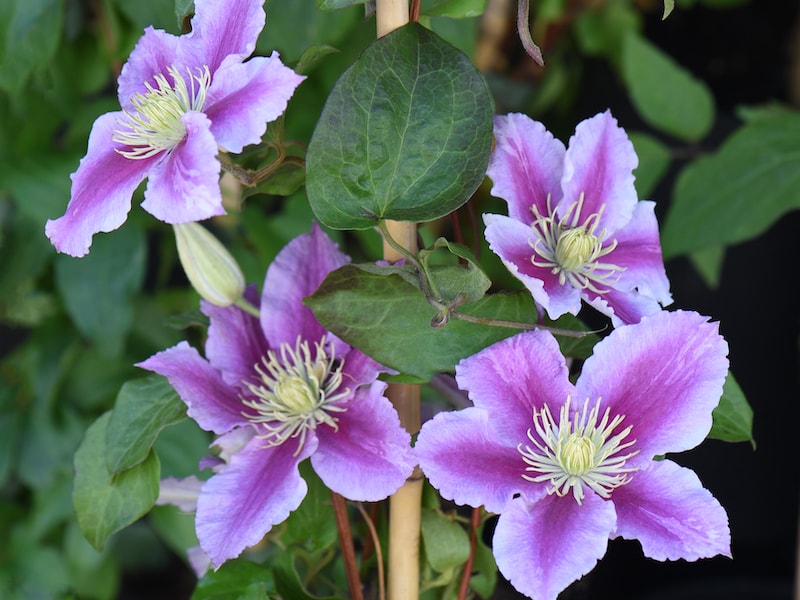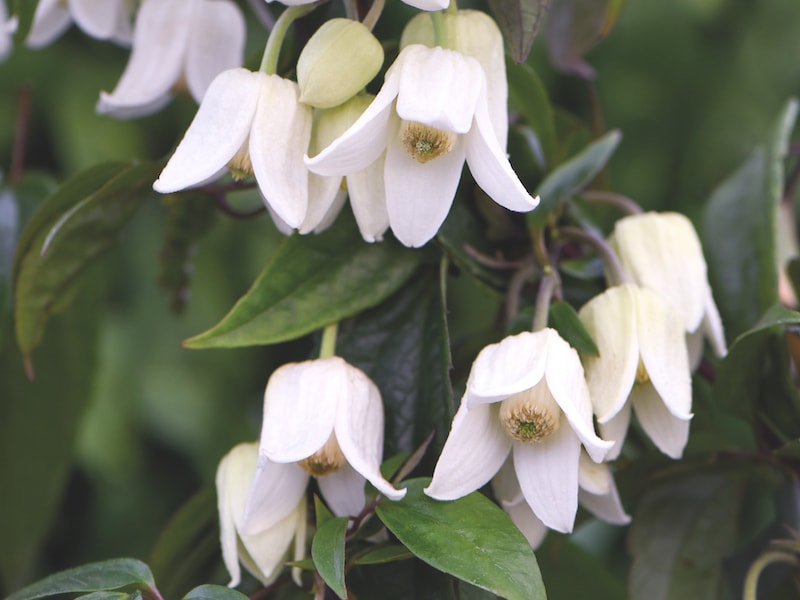Known as the ‘Queen of Climbers’, clematis is an immensely popular and mostly hardy plant that includes many different varieties. Producing everything from wide, showy blooms of pink and purple to delicate white bells, clematis plants are easy to grow and care for.
Whether you’re after a vigorous or compact variety, look for a clematis that perfectly suits the conditions in your garden. Browse our full range of climbing plants for even more inspiration.
Where to plant clematis

Image: Clematis Plant – Piilu from Suttons
All types of clematis love a sunny spot. Although some can cope with partial shade, they flower much more successfully in full sunlight. While they prefer well-drained, moist, fertile soil, they’re reasonably tolerant of most soil types. Just dig in some well-rotted organic matter before planting your clematis, particularly if you have sandy or heavy soil.
The more compact varieties do well in containers, but vigorous climbers are best planted in the ground, with a support such as a mesh or trellis to help them cover a wall or fence. Training a containerised clematis up a smaller trellis or obelisk makes for an attractive display.
When to plant clematis

Image: Clematis armandii ‘Snowdrift’ from Suttons
These sun-worshippers need to keep their roots cool so it’s best to plant them in late spring or early autumn. If you do plant one in summer, you’ll need to water it regularly to help the roots establish.
If planting in a pot, add a surface layer of pebbles or gravel to keep the soil cool. Alternatively, plant summer bedding plants around the base of your clematis to provide low-level shade.
Planting depth varies according to the type of clematis. Most types can be planted with the top of the root ball just below the surface of the soil. Large-flowered varieties should be planted with the top of the root ball a few inches below the surface of the soil, which encourages new shoots to grow from below ground level and also reduces the risk of a fungal disease called clematis wilt. If you plan to train your plant up a wall or fence, position the hole 1-2ft away from the vertical surface. Once planted at the appropriate depth, fill in and water well.
How to care for clematis plants

Image: Clematis ‘Star of India’ from Suttons
Newly-planted clematis require regular watering, particularly in dry weather, as they become stressed without access to moisture. Once the plants are established, they won’t need to be watered as much except during prolonged spells of dry weather or if grown in containers.
These plants will grow better and produce more flowers if fed regularly. An annual feed of potassium-rich fertiliser in late winter or early spring is enough for clematis growing in the ground, while containerised plants benefit from monthly feeds of a general fertiliser throughout spring and summer.
Mulching around the plants in late winter with well rotted organic matter, such as compost or manure, further improves the soil and helps to keep it moist. Clematis grown in containers requires just a little extra care – remove the top layer of soil each spring and replace it with fresh compost.
How to prune clematis plants

Image: Clematis ‘Winter Beauty’ from Suttons
It’s a good idea to tie in your clematis. Climbing varieties have delicate stems that can become tangled and congested if left untrained, while the sprawling stems of herbaceous clematis may benefit from additional support. Use soft twine or foam-covered twist-ties to carefully tie your clematis stems to their supports. Plastic ties are not recommended as they can damage the plant.
Pruning is also important for strong, healthy and tidy plants. Some types of clematis are very fast-growing and can become unruly without regular trimming. Newly-planted clematis should be pruned immediately if planted in spring, or the following spring if planted in autumn. Simply remove weak or damaged shoots and cut back to just above healthy buds. Overgrown plants will, in most cases, tolerate hard pruning to bring them under control.
Established clematis should be pruned according to when they flower.
- Group 1 (varieties that flower in winter and early spring) should be pruned straight after flowering.
- Group 2 (large-flowered hybrids that bloom May-June) and twice-flowering types can be pruned in late winter or early spring and again after their early summer flowering.
- Group 3 (summer-flowering climbers and herbaceous clematis) should be pruned in late winter or early spring.
Hybrid cultivars are susceptible to clematis wilt. If you suspect this, prune out all affected growth and burn it. Pests such as aphids, slugs and earwigs can damage these plants, which can occasionally lead to bacterial infection of the stems. Trap and remove slugs and earwigs, and rid plants of aphids by knocking them off with a strong jet of water.
Easy-to-grow clematis plants come in a fantastic variety of colours and shapes. Take a look at our extensive range of climbing shrubs and cottage garden plants for even more ideas.
Lead image: Clematis ‘Montana Mayleen’ from Suttons
Last Updated on November 8, 2024 by Suttons Horticultural Team





